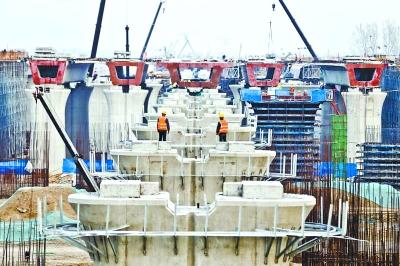Jingtang Jingbin High-speed Railway Baodi Section Completed Resumption
Our correspondent Feng Jiawei correspondent Chen Zhen
With the improvement of the epidemic prevention and control situation, the construction of the Jingtang and Jingbin intercity railways crossing the Baodi District of Tianjin was resumed in an orderly manner. At present, the first and second bid sections of the Jingbin High-speed Railway and the fourth and fifth bid sections of the Jingtang High-speed Railway in Baodi District have been fully resumed.
The new Beijing-Tangshan railway line of the Beijing-Tangshan intercity railway project starts from the Beijing City Sub-Central Station, passes through Tongzhou District of Beijing, Langfang City of Hebei Province, Baodi District of Tianjin City, Tangshan City of Hebei Province, and ends with the existing Tianjin-Qinhuangdao High-speed Railway Tangshan Station, the main line is about 148.7 kilometers long.
The Jingbin Intercity Railway, also known as the Beijing-Tianjin Second Intercity Railway, is an important intercity express railway serving the Bohai Rim and the Beijing-Tianjin-Hebei region. The starting point is at Beijing Railway Station and the end point is at Binhai West Railway Station in Binhai New District, Tianjin. The line is 171.7 kilometers long.
Baodi South Station is a station shared by the three intercity high-speed railways of Jingtang, Jingbin and Jincheng, covering an area of about 10.2 square kilometers. According to the planning of Baodi District, the vision of Baodi South Railway Station is to build a 30-square-kilometer "high-speed rail new zone" and a "micro-center" that undertakes the function of Beijing's non-capital.
"The construction of Baodi South Station is the most difficult and is the largest hub station on the entire Jingtang line." Zhang Qing, the site deputy manager of the second branch of the fourth division project department of the Jingtang Railway of the China Railway 12th Bureau Group, introduced that Baodi South Station is a large scale and has 26 sets of turnouts, 17 joint turnout beams, Jingtang, Jingbin and the Jincheng high-speed rail to be built later will be gathered here. There are many turnout beams and large volumes, which are non-standard beams and cannot be prefabricated in the factory area. All need to be cast on site . Baodi has many waters and canals, and the construction site environment is also complicated. In view of such a situation where there is a lot of interference in construction, the construction of the steel pipe column beret beam combined with the full frame support is adopted to ensure the smooth progress of the construction period.
Wang Xiaogang, the project chief engineer of the project manager department of the first section of the Beijing Railway, China Railway First Bureau Group Co., Ltd. introduced that due to the small construction distance between the two railways and the limited space, the construction period needs to be coordinated with the Jingtang High Speed Railway from the foundation construction, substructure and box beam Erection, the two units work closely together. After the pre-fabricated beams of the cross section are completed by the Jingtang High Speed Rail, the intersecting parts of the Jingbin High Speed Rail can only be covered.
Resumption of work in extraordinary times, we must first solve the housing problems of project builders. To this end, the project party has also adopted countermeasures according to local conditions.
The 5th bid section of Jingtang Intercity Railway is located in Baodi District, with a total length of about 26.9 kilometers. In mid-February, the project submitted an application for resumption of work, and plans to pick up the workers in batches of "point-to-point" chartered vehicles. Because the previous project builders were rented in the villages along the route, during the epidemic prevention, these villages were strictly controlled by the outside world.
In order to solve this problem, the project party proposed to place containers along the route as temporary dormitories. The Baodi District High Speed Rail Office quickly contacted the towns and industrial parks along the line, set specific placement points, and formulated safety and prevention plans for each container. In just 3 days, more than 140 containers were placed in place. The High Speed Rail Office assisted the project department to use electricity for construction along the line. , Air conditioners were installed in each container, and heating was done, and the workers moved in immediately. On March 3, the first batch of workers was isolated and the project was officially resumed.

